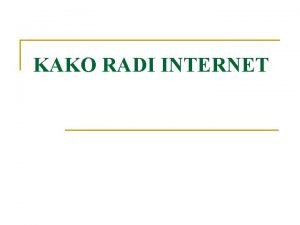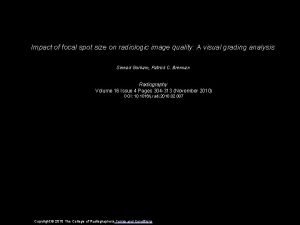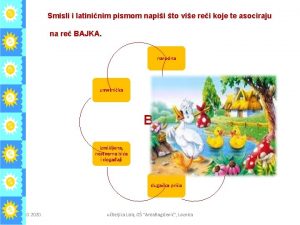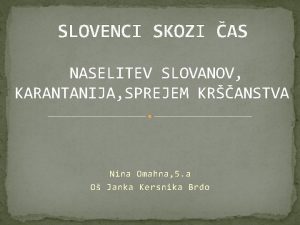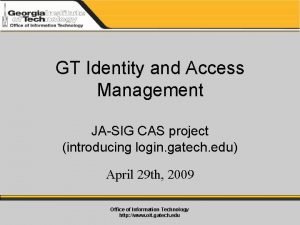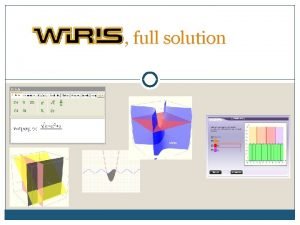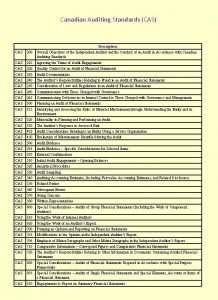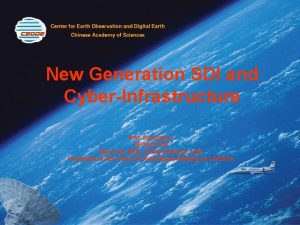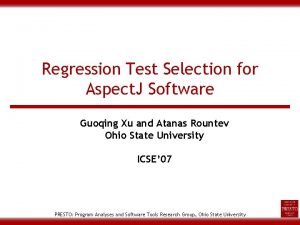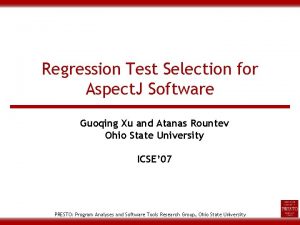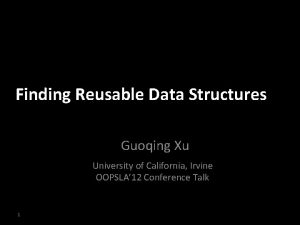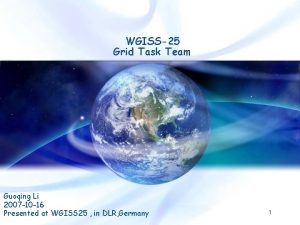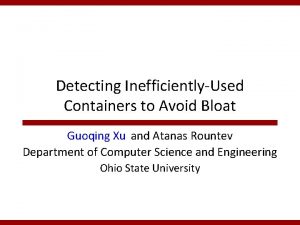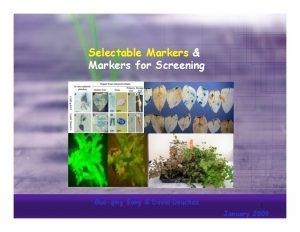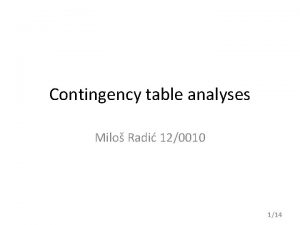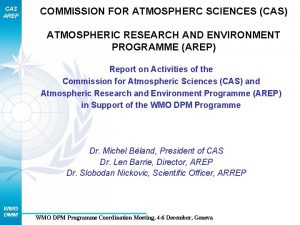Introduction to RADI CAS Li Guoqing RADI CAS






























- Slides: 30

Introduction to RADI, CAS Li Guoqing RADI, CAS presented to 44 th WGISS, Beijing Sept 25, 2017

About RADI The RADI is an independent research institute affiliated to the Chinese Academy of Sciences for remote sensing and digital Earth. Mission • Reception, processing, archiving and dissemination of remotely sensed data. • Research and development on supporting new earth observation system, improving remote sensing data processing and analytical methodologies, and promoting multidisciplinary applications based on earth observation technology. • Theoretical and technological research into key issues concerning Geo-spatial Information science and Digital Earth Platform. They are involved together in solving some environmental problems at the global, regional and national scales.

History n 1979, Institute of Remote Sensing Applications (IRSA), CAS n 1985, Airborne Remote Sensing Center, CAS n 1986, Chinese Remote Sensing Satellite Ground Station, CAS n 2007,Center for Earth Observation and Digital Earth (CEODE), CAS n 2012, Institute of Remote Sensing and Digital Earth (RADI), CAS 2007 1979 1985 1986

Organization

Staff The institute currently has 697 employees and nearly 600 students. 3 CAS Members, 4 awardees of Thousand Talents Program and 1 National Science Fund for Distinguished Young Scholars, and 12 awardees of CAS Visiting Professorship for Senior International Scientists.

Campus Adv. -tech. Camp. Olympic Vil. Camp. Miyun Station Sanya Station Kashi Station L. X. Airport

Spaceborne-airborne-ground remote sensing data acquiring and processing capacity China Remote Sensing Satellite Ground Station a member of the Landsat Ground Station Operations Working Group, boasts one of the world's highest capacities for receiving, processing, and distributing satellite data. With over 3. 3 million scenes of satellite data filed since 1986, it is regarded as the largest Earth observation satellite data archive in China.

• RADI ground station network with more than 20 antennas brings coverage capacity of 70% Asia area. • The Kiruna station began operating at 2016. • RADI is serving for the data receiving of 17 Chinese satellites, such as CBERS, ZY, HJ, GF, as well as dozen of scientific statellites of CAS. • Three stations of RADI have joined the Landsat global station network since 1986.

Cessna Citation S/II u Two Remote Sensing Aircrafts n n n Round-the-clock flying capability; Equipped with various airborne remote sensors, and can be used to test newlydeveloped advanced sensors; Provides high-resolution satellite data. u Two new Remote Sensing Aircrafts n Technical Index Max Altitude Max Range Max Speed Equipped with 10 state-of-the-art remote sensors: visible, infrared, and microwave remote sensors and a high-performance data processing system. Airborne atmospheric laser radar Digital CCD camera Airborne whiskbroom imaging spectrometer (0. 45 m-12. 5 m) Airborne 3 -D light detection and ranging 13, 000 m 3, 300 km 746 km/h New Airplane Airborne X-band interferometry SAR Airborne pushbroom imaging spectrometer (0. 45 m-2. 5 m)

Experimental Observation Systems Indoor control simulation test Research on mechanism of radiative transfer, new theories and methods of earth observation Field multi-platform real scene test Verification on mechanism of radiative transfer; test on new theories and methods of earth observation; research on testing method for validation of pixel level Network construction for validation test in remote sensing Verification of remote sensing parameter inversion; validation test for remote sensing applications and data

Remote sensing science and spatial information research capacity n Building All-band remote sensing mechanism simulation system, providing remote sensing theory and key technologies for Earth system key factors; n Erecting an advanced space remote sensing payload verification system, testing the new sensors for a variety of satellites, including satellite for water cycle observation, satellite-borne Lidar, China-Brazil Earth Resources Satellite and hyperspectral satellites. n Building up a Earth observation system simulation platform, providing planning support national major special projects. Major Special Projects Spatial Infrastructure for Natural Disasters National Spatial Infrastructure Plan

Digital Earth science platform and global environmental resources information analytical ability CAS Key Laboratory of Digital Earth Science n Developing the first Digital Earth Science Platform and establishing global resource-environmental spatial information system on the basis of the platform and the concept of “new generation Digital Earth” ; n Developing more than 30 spatial information products of global resource-environment, being adopted by many national information release platforms. A new CAS funded progamme of Big Earth Data will be launched since 2018 (about 2 billions RMB). 12

Digital Earth Applications Global Climate Change Digital City Food and Water Insecurity Natural Disaster Energy Resources n 30 categories of products, including land, n Time-space scale: long-time series in ocean, atmosphere, urban construction; global and regional scales.

International Cooperation

International Cooperation Global network/connections: partners in over 20 countries International Organizations Government, Institutions & Universities Companies

International organization hosted by RADI International Center on Space Technology for Natural and Cultural Heritage under the auspice of UNESCO (HIST) International Program Office of Integrated Research on Disaster Risk (IRDR IPO) CAS-TWAS Center of Excellence on Space Technology for Disaster Mitigation (SDIM) International Society for Digital Earth (ISDE) International Journal of Digital Earth (IJDE)

International Center on Space Technology for Natural and Cultural Heritage under the auspice of UNESCO n Hosted by RADI, it is the First UNESCO Category II Center in CAS & First UNESCO International Center to apply space technologies to the monitoring and preserving natural and cultural heritage. Research Works n Remote Sensing for the Environment of the Historic Heritage Site of Angkor n Analyses of natural and cultural heritage evolution and change. n Natural and cultural heritage imagery database n Atlas of Remote Sensing for World Heritage: China being published in 2011.

International Society for Digital Earth § ISDE, founded in Beijing in 2006, is a international scientific organization principally promoting academic exchange, science and technology innovation, education, and international collaboration towards Digital Earth. § The Mission of the Society is to benefit society by promoting the development and realization of Digital Earth. International Society for Digital Earth • • Time: May 2006 Place: Beijing , China • Official Launch of ISDE and the first Executive Committee Meeting 学会成立大会 The first EC meeting EC member of ISDE Launch Ceremony of ISDE

International Programme Office for Integrated Research on Disaster Risk Being hosted by RADI (approved in November, 2009). First International Office of a large science program ever established in Asia. IRDR CHINA established in 2010, one of the national committees of IRDR Addressing the challenge of natural and human-induced environmental hazards An integrated approach to research on disaster risk through: an international, multidisciplinary (natural, health, engineering and social sciences, including socioeconomic analysis) collaborative research programme.

CAS-TWAS Centre of Excellence on Space Technology for Disaster Mitigation (SDIM) SDIM is committed to the studies of some key technologies of disaster reduction by using remote sensing, and focus on cooperation and capacity building for the developing countries. TWAS, Trieste, Italy Joint Research Program Education Training Workshop CAS, Beijing, China Conference and Seminar

CAS-NASA Join hands in HMA Glacier Research using Earth Observations Within the framework of the China-US Joint Announcement on Climate Change and Cooperation between China and US Governments on Civil Space Technology, CAS and NASA kicked off joint glacier research in the HMA region using Earth Observations since 2014. The NASA ESD in collaboration with CAS RADI. Two main themes: • Glacier change. The changing climate, and human impacts have implications for glacier size and melt. • Glacier hazards, observations of hazards, and downstream effects on ecosystems and water resources. Three Joint task groups: The Joint task groups process • pool the advantages of the two sides in EO modeling and glacier and snow cover studies; • develop decision support tools for the • data sharing sustainable development of the region; • promote the establishment of a mechanism scientific underlying the long-term Sino-US verification cooperation on global change over HMA. Output: • Collaborate to complete the white paper in 2016. • NASA and CAS Fund projects for collaborate research separately in 2016. 1 st CAS-NASA Workshop in Nepal in Jan 2015 2 nd CAS-NASA Workshop in USA in Sep 2015 3 rd CAS-NASA Workshop in China in Mar 2016. NASAAdministrator. Charles. F. Boldenand the. USAdelegationvisit. RADI

Asia-Oceania Global Earth Observation System of Systems (AOGEOSS) GEO Initiative(GI-22 ) • Asia-Oceania region – – – Complex geographic Large population (70% of world’s) Climate change drastically Natural disasters occur frequently Unbalanced socioeconomic development Deteriorating ecological environment • Asia-Oceania GEOSS---a regional cooperation program on Earth observation with broad involvement • Strengthen comprehensive ability of Earth observation and applications for sustainable development at regional level.

AOGEOSS Functional Architecture p Biodiversity and Ecosystem Sustainability p Disaster Resilience p Energy and Mineral Resources Management Improving regional observing ability Regional applications p Food Security and Sustainable Agriculture p Infrastructure and Transport Management p Public Health Surveillance p Sustainable Urban Development p Water resources Management AOGEOSS Technology cooperation network Data and information products processing Earth observation data sharing service

AOGEOSS Activities 24

“Digital Belt And Road (DBAR)” Initiative DBAR: Hand in Hand Program Countries along the Belt and Road International programs International organizations Let countries along the Belt and Road benefit from DBAR

DBAR Objectives • Scientific contributions To address knowledge gaps in Earth system processes, which are limiting the achievement of the SDG targets in the Belt and Road countries. • Facilitating platform To promote advanced science and decision support services to extract effective information from massive and diverse data in light of Big Earth Data. • Stakeholders To enhance capacity building and technology transfer towards a system of partnerships and research networks.

Conceptual Framework of DBAR

DBAR Working Groups Big Earth Data (DBARDATA) Co-Chairs: LI Guoqing Silap Boupha Coastal Zone (DBAR-COAST) Co-Chairs: LI Zhang LIN Hui Mazlan bin Hashim Natural and Cultural Heritage (DBAR-HERITAGE) Co-Chairs: WANG Xinyuan Shahina Tariq Rosa Lasaponara Houcine Khatteli Water (DBAR-WATER) Co-Chairs: JIA Li Marco Mancini Bob Su Agriculture and Food Security (DBAR-AGRI) Co-Chairs: WU Bingfang Shukri Ahamd Environment Change (DBARENVI) Co-Chairs: LI Xinwu JIA Gensuo Howard E. Epstein Disaster Risk Reduction (DBAR-DISASTER) Co-Chairs: CHEN Fang Rajib Shaw

On behalf of NRSCC, RADI, and its former bodies, has continually partcipated the activities and plenaries of WGISS from 2003. RADI will support WGISS and other CEOS activies in the future.

 Piplmetar kako radi
Piplmetar kako radi Glagoli o suncu
Glagoli o suncu Kako radi internet
Kako radi internet Radi s
Radi s E imenik učenici
E imenik učenici Effect of focal spot size on image quality
Effect of focal spot size on image quality Nino radi
Nino radi Polinomi
Polinomi Introduction to cas
Introduction to cas Cas d utilisation uml
Cas d utilisation uml Cas treatment approaches
Cas treatment approaches Princeza na zrnu graska pdf
Princeza na zrnu graska pdf úlohy o pohybu proti sobě
úlohy o pohybu proti sobě Naselitev slovanov
Naselitev slovanov Controlagro cas 4500 manual
Controlagro cas 4500 manual Leren hacken voor beginners
Leren hacken voor beginners Cas access management
Cas access management Wiris desktop
Wiris desktop Dostojevski zločin in kazen
Dostojevski zločin in kazen Paraverbalna komunikacija primjer
Paraverbalna komunikacija primjer Raisonnement et démarche clinique infirmière exemple
Raisonnement et démarche clinique infirmière exemple Ipard cas
Ipard cas Overall cas progress
Overall cas progress Cas definition ib
Cas definition ib Overall cas progress
Overall cas progress Cas clinique infirmier chirurgie
Cas clinique infirmier chirurgie Mammographie
Mammographie Casa de sanatate calarasi
Casa de sanatate calarasi Cas definition ib
Cas definition ib Cas 570
Cas 570 Cas activity examples
Cas activity examples


